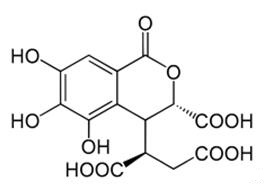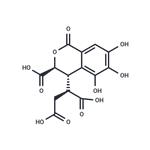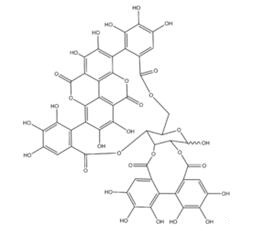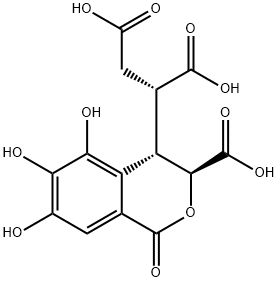Chebulic acid – a phenolic compound with many bioactivities
Dec 16,2019
Chebulic acid is a phenolic compound isolated from the ripe fruits of Terminalia chebula.[3]
This compound possesses an isomer, neochebulic acid. Chebulic acid is a component of transformed ellagitannins such as chebulagic acid or chebulinic acid [1].

Chebulic acid (CA) isolated from T. chebula, which has been reported for treating asthma, as a potent anti-oxidant resources. Exposure to ambient urban particulate matter (UPM) considered as a risk for cardiopulmonary vascular dysfunction. To investigate the protective effect of CA against UPM-mediated collapse of the pulmonary alveolar epithelial (PAE) cell (NCI-H441), barrier integrity parameters, and their elements were evaluated in PAE.
Chebulic acid was acquired from the laboratory previous reports. UPM was obtained from the National Institutes of Standards and Technology, and these were collected in St. Louis, MO, over a 24-month period and used as a standard reference. To confirm the protection of PAE barrier integrity, paracellular permeability and the junctional molecules were estimated with determination of transepithelial electrical resistance, Western Blotting, RT-PCR, and fluorescent staining. UPM aggravated the generation of reactive oxygen species (ROS) in PAE and also decreased mRNA and protein levels of junction molecules and barrier integrity in NCI-H441. However, CA repressed the ROS in PAE, also improved barrier integrity by protecting the junctional parameters in NCI-H411. These data showed that CA resulted in decreased UPM-induced ROS formation, and the protected the integrity of the tight junctions against UPM exposure to PAE barrier [2].
Advanced glycation end-products (AGEs) have been implicated in the development of diabetic complications. Ji-young Lee etc. reported the antiglycating activity of chebulic acid (CA), isolated from Terminalia chebula on breaking the cross-links of proteins induced by AGEs and inhibiting the formation of AGEs. Aminoguanidine (AG) reduced 50% of glycated bovine serum albumin (BSA) with glycolaldehyde (glycol-BSA)-induced cross-links of collagen at a concentration of 67.8¬2.5 mM, the level of CA required for exerting a similar antiglycating activity was 38.8¬0.5 μM. Also, the breaking activity on collagen cross-links induced by glycol-BSA was potent with CA (IC50 1.46-0.05 mM), exhibiting 50-fold stronger breaking activity than with ALT-711, a well-known cross-link breaker (IC50 72.2¬2.4 mM). IC50 values of DPPH• scavenging activity for CA and ascorbic acid (AA) were 39.2¬4.9 and 19.0¬1.2 μg dry matter (DM) mL-1, respectively, and ferric reducing and antioxidant power (FRAP) activities for CA and AA were 4.70¬0.06 and 11.4¬0.1 mmol/FeSO4•7H2O/g DM, respectively. The chelating activities of CA, AG and ALT711 on copper-catalyzed oxidation of AA were compared, and in increasing order, ALT-711 (IC50 of 1.92-0.20 mM)<CA (IC50 of 0.96¬0.07 mM)<AG (0.47¬0.05 mM). Thus, CA could be a breaker as well as an inhibitor of AGE cross-linking, the activity of which may be explained in large part by its chelating and antioxidant activities, suggesting that CA may constitute a promising antiglycating candidate in intervening AGE-mediated diabetic complications [3].
The extraction of Chebulinic acid from Terminalia chebula by Soxhlet extraction and purify the Chebulinic acid by using Column chromatography. From the Soxhlet extraction the Chebulinic acid concentration was 6.6 mg/ml and it was increased to 9.4mg/mL from the Column chromatography. The purity of Chebulinic acid was improved by Column chromatography. Among the extraction process (Batch, Soxhlet & Fermentation process) the highest Chebulinic acid production was obtained from fermentation process. From the batch process the chebulinic acid concentration was observed to be 3.4mg/ml at 60 min and the concentration was increased to 6.6mg/ml at 75 min from soxhlet extraction. Similarly, the concentration of chebulinic acid was increased to 8.6mg/ml at 192 hours from fermentation process. The partition coefficient for fermentation, soxhlet & batch extraction were found to be 3.83, 2.0 & 0.64.
Chebulinic acid showed many bioactivities including inhibition of cancer cell growth, inhibiting the contractile responses of cardiovascular muscles, anti-fungal, anti-bacterial activities etc. In-vitro anti-cancer activity of Chebulinic acid on Colon adenocarcinoma HT-29 cancer cell lines by using MTT cell growth inhibition assay was stuied. The maximum percentage inhibition of cancer cell lines for Chebulinic acid was found to be 41.2% at a dose of 200µg/ml. Chebulinic acid extraction from Terminalia chebula plays a vital role in medicine, biotechnology and various pharmacological activities.
References
[1] https://en.wikipedia.org/wiki/Chebulic_acid
[2] Kyung-Won Lee, Mi-Hyun Nam, Hee-Ra Lee, Chung-Oui Hong and Kwang-Won Lee, Protective effects of chebulic acid on alveolar epithelial damage induced by urban particulate matter, BMC Complementary and Alternative Medicine (2017) 17:373.
[3] Ji-young Lee, Jun-Gu Oh, Jin Sook Kim, and Kwang-Won Lee, Effects of Chebulic Acid on Advanced Glycation Endproducts-Induced Collagen Cross-Links, Biol. Pharm. Bull. 37(7) 1162–1167 (2014).
- Related articles
- Related Qustion
- Chebulic Acid: activities, mechanism of action and applications Dec 1, 2023
Chebulic acid possesses diverse pharmacological activities and potential therapeutic applications.
Glucoraphanin is a glucosinolate found in broccoli, cauliflower, and mustard. Glucoraphanin is converted to sulforaphane by the enzyme myrosinase. In plants, sulforaphane deters insect predators and acts as a selective antibiotic.....
Dec 16,2019Plant extractsPunicalagin is an ellagitannin, a type of phenolic compound. It is found in forms alpha and beta in pomegranates (Punica granatum), in Terminalia catappa and Terminalia myriocarpa, and in Combretum molle, the velvet bushwillow.....
Dec 16,2019Plant extractsChebulic Acid
23725-05-5You may like
- Kuromanin chloride: Synthesis and properties
Dec 12, 2025
- Synephrine: use,mechanism and risk assessment
Nov 3, 2025
- Pharmacology research of Genipin
Oct 15, 2025
- Chebulic acid
-

- $122.00 / 1mg
- 2025-12-10
- CAS:23725-05-5
- Min. Order:
- Purity: 99.98%
- Supply Ability: 10g
- Butanedioic acid,[(3S,4S)-3-carboxy-3,4-dihydro-5,6,7-trihydroxy-1-oxo-1H-2-benzopyran-4-yl]-,(2S)-
-
![23725-05-5 Butanedioic acid,[(3S,4S)-3-carboxy-3,4-dihydro-5,6,7-trihydroxy-1-oxo-1H-2-benzopyran-4-yl]-,(2S)-](https://img.chemicalbook.com/ProductImageEN/2020-1/Small/8bc99468-0952-462c-b2a2-9c76546d4ce8.jpg)
- $9.80 / 1KG
- 2020-01-10
- CAS:23725-05-5
- Min. Order: 1KG
- Purity: ≥98%
- Supply Ability: 20 tons






